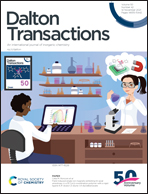Coordination anion effects on the geometry and magnetic interaction of binuclear Dy2 single-molecule magnets†
Abstract
Two new dimeric dysprosium(III) complexes, [Dy2(HL)2(SCN)2]·2CH3CN (1) and [Dy2(HL)2(NO3)2]·2CH3CN·2H2O (2), have been assembled using the H3L multidentate ligand (H3L = 2,2′-((((2-hydroxy-5-methyl-1,3-phenylene)bis(methylene))bis((pyridin-2-ylmethyl)azanediyl))bis(methylene))diphenol). The use of different coordination anions for the two complexes results in distinct coordination geometries of the metal sites. The Dy centers in complexes 1 and 2 display capped octahedron and triangular dodecahedron coordination geometries, respectively. Consequently, the two compounds exhibit distinct dc and ac magnetic properties. Complex 1 behaves as a single molecule magnet (SMM) while no SMM behavior is observed for complex 2. Although complexes 1 and 2 possess a similar core of Dy2O2, their different coordination anions lead to two distinct magnetic interactions, namely ferromagnetic and antiferromagnetic, respectively. Ab initio calculations reveal that these interactions may result from strong intramolecular dipolar couplings that are ferromagnetic for 1 but antiferromagnetic for 2, while exchange couplings are antiferromagnetic in both cases.



 Please wait while we load your content...
Please wait while we load your content...